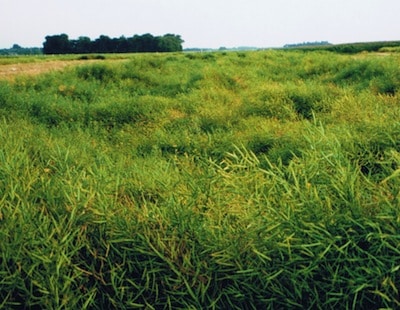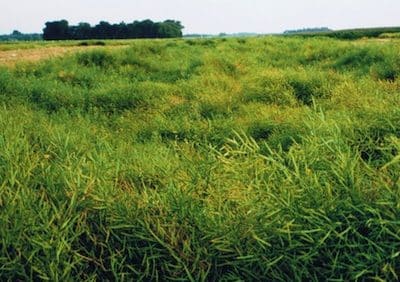
The ideal swath timing is when 60% of seeds on the main stem are showing some colour change from green to brown. However, various factors complicate the swath timing decision, including frost and uneven crops due to hail. A few other scenarios surfaced this week:
1. Not started. Some growers haven’t started swathing anything and some are concerned that everything is going to happen at once. This is a risk, especially if there’s a heavy frost and suddenly all canola has to be swathed immediately to prevent high shattering losses. Growers in this situation have incentive to start swathing now, even if crops have not reached 60% seed colour change on the main stem. In this situation, if you can at least wait until all seeds on side branches are firm and roll between finger and thumb, most yield potential will be salvaged, even if seeds do not fill fully. Any seeds that do not pass this firmness test are not mature and will wither up in the swath and be lost.
2. Sclerotinia stem rot is severe. Sclerotinia needs living viable plant tissue to survive and spread, so swathing early will stop the disease as long as the crop is drying down. However swathing early also prevents the healthy plants from maturing completely. Sclerotinia spreading to healthy plants at this stage of the season is unlikely to have a major impact on yield on these healthy plants, so cutting early to prevent this spread may actually hurt yield, not preserve it. On the other hand, if sclerotinia infection is very high and infected plants represent most of the yield, cutting early to stop the disease and limit further disease advancement that could promote higher shattering losses might be the best choice. This is a tough decision with no clear answer.
3. Bad patches. When assessing disease severity and whether to swath early, check the whole field to see what areas are affected. If the disease is in pockets and represents only 15% of the field, for example, making a swath timing decision on this small percentage may actually hurt overall yield in the end. Swathing the whole field too green because of a small area of disease will reduce yield and could compromise profitability for the crop.
4. Lodging. Lodged crop is hard to swath, and does not always mature quickly or evenly. Desiccant may be required to dry down later plants so the crop can be harvested efficiently. (Note that desiccant will not speed maturity, instead it stops maturity and quickly dries down plants at whatever stage they’re at.) Try to figure out why lodging occurred. Possible reasons include leggy crop in low areas, disease-weakened stems, heavy pounding rain, and poor lodging resistance. Figuring out the cause may help with variety and management decisions next year. When swathing lodged crop make sure the knives are sharp. Vertical knives help, too.
Further reading:
Swathing variable fields.

